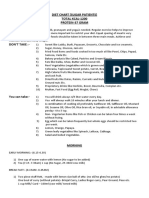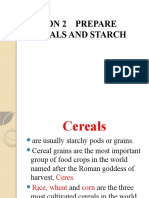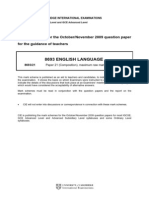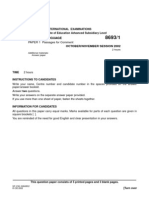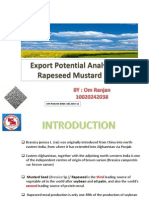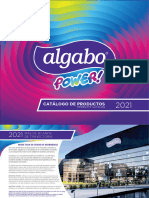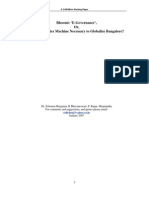Maximum Mark: 100: University of Cambridge International Examinations General Certificate of Education Ordinary Level
Maximum Mark: 100: University of Cambridge International Examinations General Certificate of Education Ordinary Level
Uploaded by
mstudy123456Copyright:
Available Formats
Maximum Mark: 100: University of Cambridge International Examinations General Certificate of Education Ordinary Level
Maximum Mark: 100: University of Cambridge International Examinations General Certificate of Education Ordinary Level
Uploaded by
mstudy123456Original Title
Copyright
Available Formats
Share this document
Did you find this document useful?
Is this content inappropriate?
Copyright:
Available Formats
Maximum Mark: 100: University of Cambridge International Examinations General Certificate of Education Ordinary Level
Maximum Mark: 100: University of Cambridge International Examinations General Certificate of Education Ordinary Level
Uploaded by
mstudy123456Copyright:
Available Formats
UNIVERSITY OF CAMBRIDGE INTERNATIONAL EXAMINATIONS General Certificate of Education Ordinary Level
FOOD AND NUTRITION Paper 1 Theory SPECIMEN MARK SCHEME
6065/01
For Examination from 2012 2 hours
MAXIMUM MARK: 100
This document consists of 13 printed pages and 1 blank page. [Turn over
UCLES 2009
2 Section A 1 (a) Elements in carbohydrate carbon hydrogen oxygen 3 1 mark (b) Uses of energy mechanical energy movement / work (or examples) chemical energy metabolism / digestion / absorption heat energy maintain body temperature electrical energy transmission of nervous impulses basal metabolism heartbeat / blood circulation / breathing, etc. credit general use or one example 4 1 mark (c) bacteria act on sugar on teeth forms plaque sugar converted to acid dissolves enamel tooth decay diabetes gum disease bad breath excess sugar converted to fat stored under skin adipose tissue around internal organs obesity CHD low self-esteem breathlessness lethargy (8 points) (2 points = 1 mark) (d) Digestion in the mouth ptyalin / amylase from salivary glands acts on cooked starch converts starch to maltose In the duodenum amylase from pancreatic juice converts starch to maltose In the ileum lactase acts on lactose converts it to glucose and galactose maltase acts on maltose converts it to glucose invertase / sucrase acts on sucrose converts it to fructose and glucose enzymes secreted by intestinal juice (12 points to cover all areas) (2 points = 1 mark) (e) Importance of NSP absorbs water swells softens faeces making it bulky helps remove waste easier to expel stimulates peristalsis absorbs toxins regularly binds waste lowers cholesterol prevents constipation reduces blood sugar hernia cancer of colon diverticular disease haemorrhoids (max. 2 e.g. from line above) (8 points) (2 points = 1 mark) (f) Sources of NSP green vegetables (or named e.g.) fruit skins and seeds (or named e.g.) nuts pulses (or named e.g.) rhubarb celery potato skins dried fruit wholegrain breakfast cereal brown rice wholemeal pasta fruit and vegetables wholemeal bread (not brown bread) wholemeal flour oats bran (4 examples (avoiding repetition)) (2 examples = 1 mark)
[3]
[4]
[4]
[6]
[4]
[2]
UCLES 2009
6065/01/SM/12
3 2 (a) Vitamin C (Ascorbic acid) FUNCTIONS to make connective tissue heals wounds absorption of iron antioxidant helps to build strong bones and teeth production of blood / walls of blood vessels build / maintain healthy skin growth (4 points) SOURCES citrus fruit (or 1 named example e.g. orange lemon lime kiwi fruit, etc.) rose hips blackcurrants melon strawberries green peppers tomatoes, etc. green vegetables (or 1 named example e.g. cabbage spinach lettuce broccoli, etc.) (3 points) DEFICIENCY DISEASE scurvy (1 point) (8 points) (2 points = 1 mark) (b) Iron FUNCTIONS formation of haemoglobin red pigment in blood transport oxygen to cells for production of energy transport carb-oxyhaemoglobin to lungs (4 points) SOURCES liver kidney corned beef cocoa / plain chocolate curry powder treacle pulses dried fruit (or named example) egg yolk green leafy vegetables (or named example) (3 points) DEFICIENCY DISEASE anaemia (1 point) (8 points) (2 points = 1 mark) [4] [4]
UCLES 2009
6065/01/SM/12
[Turn over
4 3 (a) Reasons for following a vegetarian diet religion Jews do not eat pork / Hindus avoid beef, etc. object to slaughter of animals animal rights think it is cruel, etc. uneconomical use of land expensive to rear animals more crops could be grown if land was used for cereals, etc. dislike taste / texture of animal flesh believe vegetarian diet is more healthy animal fat is saturated / contains cholesterol animal products are more expensive than plant products cereals / pulses cheaper than meat peer pressure follow trends family upbringing brought up to follow certain dietary pattern, etc. (6 points) (2 points = 1 mark) [3] (b) HBV protein in a vegetarian diet lacto-vegetarians can have eggs cheese milk (max. 2 e.g.) can combine 2 LBV protein foods pulses cereals nuts (max. 2 e.g.) IAAs missing in one will be compensated by other e.g. beans on toast / lentil soup and bread / rice and peas (1 e.g.) can combine HBV and LBV proteins quality of LBV protein improved e.g. egg on toast / cereal and milk / cheese scones (1 e.g.) soya HBV from plant source soya products flour milk (not oil or soy sauce) TVP meat substitute texture resembles meat e.g. mince / sausages / chunks (max. 2 e.g.) (12 points) (2 points = 1 mark)
[6]
[Section A Total: 40 marks]
UCLES 2009
6065/01/SM/12
5 Section B 4 (a) Points to consider when planning meals time of year hot food in cold weather, etc. religion special diet/vegetarian foods in season garden produce availability of food food in stock closeness of shops ages of those having the meal variety of colour variety of flavour variety of texture occasion packed meal / Christmas lunch / birthday party, etc. both courses in same plane not a complex first course and simple dessert money available time available use of convenience foods less time but more expensive equipment available use of labour-saving equipment microwave skill of cook individual likes and dislikes activities of those eating meal manual workers need more energy foods state of health of those eating meal, etc. NB do not credit points relating to nutrients (6 points) (2 points = 1 mark) (b) Nutritional requirements of elderly fewer carbohydrate foods less active protein needed repair worn out cells iron to prevent anaemia vitamin C to absorb iron calcium / phosphorus maintain bones / teeth blood clotting muscle function vitamin D to absorb calcium reduce fat reduce risk of obesity / CHD reduce sugar link to diabetes reduce salt risk of hypertension / high blood pressure (12 points) (2 points = 1 mark)
[3]
[6]
(c) Importance of fresh fruit and vegetables vitamin C not stored daily supply needed for prevention of scurvy / healthy skin / absorption of iron, etc. vitamin A mucous membranes / visual purple / prevents night blindness, etc. iron green veg pulses prevent anaemia carbohydrate starch and sugar energy calcium bones and teeth green veg NSP peristalsis / makes faeces easier to expel / prevents constipation, etc. water quenches thirst prevents dehydration / body fluids / keeps body cool / eliminates waste, etc. NB allow only one function of each nutrient no fat (except avocado) filling helps to avoid sugary / fatty snacks provide variety of colour flavour texture examples to illustrate many dishes can be made soup / drinks / accompaniments / salads, etc. (max. 3 uses of fruit and vegetables) can be eaten raw or cooked useful snack foods easy to carry easy to eat, etc. (12 points) (2 points = 1 mark) [6]
UCLES 2009
6065/01/SM/12
[Turn over
6 5 (a) Coagulation heat on protein begins at 60 C cannot be reversed hardens / sets chemical structure changes overheating causes protein to shrink e.g. syneresis when scrambled egg is overcooked or baked egg custard is overcooked e.g. boiled egg, baked egg custard, quiche, baked bread, skin on boiled milk, coating on fried fish, etc. (6 points (must include one example)) (2 points = 1 mark) [3] (b) Fermentation yeast produces carbon dioxide and alcohol with food / sugar moisture warmth time enzymes bring about fermentation process amylase in flour changes starch to maltose maltase in yeast changes maltose to glucose zymase in yeast changes glucose to carbon dioxide and alcohol e.g. bread making (6 points (must include one example)) (2 points = 1 mark) (c) Gelatinisation moist heat on starch grains soften swell absorb water some rupture releasing starch granules liquid thickens irreversible e.g. roux sauce, custard, boiled rice, etc. (6 points (must include one example)) (2 points = 1 mark)
[3]
[3]
(d) Hydrogenation makes fat solid from liquid oil e.g. sunflower / soya unsaturated fats become saturated fats can take up hydrogen breaks double bond using a nickel catalyst can stop at any time to achieve degree of hardness required hard margarine more saturated soft / spreading margarine less saturated e.g. margarine, cooking fats (6 points (must include one example)) (2 points = 1 mark) [3] (e) Pasteurisation heat destroys harmful bacteria e.g. those causing tuberculosis and souring bacteria lasts longer does not prevent decay 72 C / 162 F for 15 seconds or 62 C65 C / 145 F for 30 minutes rapid cooling to prevent bacterial growth little change to nutritive value e.g. milk (6 points (must include one example)) (2 points = 1 mark) [3]
UCLES 2009
6065/01/SM/12
7 6 (a) (i) Kneading develops gluten protein in flour forms elastic dough stretches during rising traps carbon dioxide smooth dough distributes yeast aerates dough stimulates action of yeast breaks down large bubbles of gas for even texture of finished dough use knuckles / heel of hand for large amounts fingertips for small pieces (6 points) (2 points = 1 mark) (ii) Proving warm place just before baking after dough has been shaped too much heat kills yeast dough will not rise left for some time cold place / refrigerator does not kill yeast slows down process but can prove overnight in refrigerator replaces carbon dioxide lost during kneading dough doubles in size avoid over-proving dough will collapse cannot recover (6 points) (2 points = 1 mark) (b) Choice of flour for bread making strong / hard flour high gluten content from spring wheat e.g. Canadian more than 10% protein allows dough to stretch plain flour yeast is raising agent wholemeal flour adds colour nutty flavour B vitamins NSP has less gluten gives closer texture more difficult for yeast to raise (8 points) (2 points = 1 mark) (c) Changes when bread is baked rapid rising enzymes work quicker with heat more carbon dioxide produced warmth encourages fermentation alcohol produced water changes to steam more raising action gluten stretches gases expand when heated heat kills yeast no further carbon dioxide produced gases continue to expand with continued heat gluten coagulates around bubbles of gas at 73 C gluten is protein alcohol evaporates vaporises below boiling point of water carbon dioxide diffuses out heat causes gases to rise on expansion starch gelatinises action of moist heat on starch crust forms on outside dry heat on starch crust lifts off as gases continue to expand oven spring browns on outside dextrinisation of starch caramelisation of sugar Maillard browning (10 points) (2 points = 1 mark)
[3]
[3]
[4]
[5]
UCLES 2009
6065/01/SM/12
[Turn over
8 Section C 7 High levels of bacteria in food can cause food poisoning. Discuss ways of preventing food poisoning when storing, preparing and cooking food. [15] The answer may include the following knowledge and understanding. Conditions for growth of bacteria warmth moisture food time suitable pH some require oxygen Symptoms of food poisoning vomiting diarrhoea headache tiredness / exhaustion abdominal pain fever double vision Storing food clean containers cool place / refrigerator covered especially high risk foods e.g. meat / fish / milk / eggs to prevent cross contamination use in rotation check use by dates fresh meat / fish use on day of purchase follow storage instructions cool leftover food rapidly use within 24 hours keep raw and cooked food separate raw meat at bottom of fridge so drips do not fall onto other foods check containers regularly weevils / rats / mice, etc. grain off floor dry place prevent multiplication of bacteria check cans for bulges indicates seal has been damaged bacteria entered food still spoils in refrigerator action of bacteria slower do not thaw then refreeze food bacteria will have multiplied in warmth bacteria dormant in freezer spoilage halted, etc. Preparing food wash hands after toilet / raw meat / vegetables with soil avoid crosscontamination no coughing / sneezing over food do not cook if ill so bacteria are not passed to others tie back / cover long hair bacteria from hair could get into food no long fingernails dirt and bacteria collect underneath clean apron no outdoor clothes avoid transfer of bacteria from outside do not touch face during food preparation handle food as little as possible cover cuts with waterproof dressings bacteria will be on skin no licking spoons / fingers bacteria from mouth transferred to food separate chopping board / knife for raw and cooked food equipment clean work surfaces clean wash up in hot soapy water clean tea towel / allow to dry in air no chipped plates used avoid introducing bacteria from dirty cloths dish cloth not to be used for cleaning floor, etc. boil / bleach dish cloth regularly kill bacteria cover waste bin clean up spills / pools of water to avoid attracting mosquitoes avoid insects / vermin wrap waste tightly bin outside kitchen no animals in kitchen animals must not use familys meal plates dispose of rubbish / waste regularly throw away / wash food dropped on floor no flies, etc. in kitchen carry bacteria etc.
UCLES 2009
6065/01/SM/12
9 Cooking food thoroughly cook foods especially meat / eggs should reach 72 C in centre maintain for 2 minutes to kill bacteria e.g. Salmonella do not keep warm reinfected with bacteria from air know source of food danger of BSE, etc. clean water supply should reheat until piping hot use food probe do not reheat after 24 hours only reheat once danger of barbecues food overcooked on outside but not hot enough in centre warmth encourages bacterial growth cook just before eating if possible serve immediately do not use raw eggs if possible in mayonnaise / marzipan danger of Salmonella do not use cracked eggs etc.
UCLES 2009
6065/01/SM/12
[Turn over
10 7 Band High Descriptor can identify conditions for bacterial growth some symptoms of food poisoning identified is able to identify and discuss several points on preventing spread of bacteria during storing, preparing and cooking food gives examples to illustrate points made understanding of the topic is apparent information is specific and generally accurate all areas of question addressed answers are detailed where appropriate some scientific facts included Part mark (1115) Total [15]
Middle some conditions for bacterial growth given may give some symptoms of food poisoning is able to identify several points on preventing the spread of bacteria during storing, preparing and cooking food some discussion or explanations given gives a few examples to illustrate points made shows a basic understanding of the topic information is basic and generally accurate some areas of question addressed gaps in knowledge will be apparent may be a few scientific facts answer will be detailed in parts and superficial in others overall lack of detail Low may give conditions for bacterial growth little information on food poisoning mentions some points on preventing spread of bacteria during storing, preparing and cooking may give examples to illustrate answer tends to be a list of statements not always accurate information is brief answers not specific little or no scientific information emphasis on one part of the question lack of knowledge will be apparent
(610)
(05)
UCLES 2009
6065/01/SM/12
11 8 The kitchen should be a safe place in which to work. Discuss the causes and prevention of accidents in the kitchen. The answer may include the following knowledge and understanding. Knives store out of the reach of children store in sheath or knife block, or with cork on point keep separate not mixed with other cutlery keep well sharpened use on a chopping board do not cut into palm of hand cut away from the body use size appropriate to task carry with blade pointing down towards floor wash individually do not put into washing up water with other cutlery wash with back of knife towards hand (also dry this way) Deep-frying pan not more than half full prevent overflowing when food is added dry food thoroughly before putting into fat water turns to steam spits put food into pan carefully / do not throw food into pan to avoid splashing dry utensils wooden handles on pans / kitchen tools poor conductor prevents burning hands pan handle turned in avoid knocking over pan should have flat base sits firmly on hot plate avoid wobbling do not overfill pan with food fat may overflow do not overheat fat / oil could ignite have lid nearby cover if ignites prevent oxygen reaching flames do not move pan if on fire no water nearby e.g. kettle water may splash into fat cause spitting of fat do not leave pan unattended do not allow children to deep fry food make sure dangers are understood turn off heat after use do not move pan until fat / oil is cold Electrical equipment plugs should be wired correctly do not attempt to wire plugs unless sure of method should be no bare wires do not use near flames do not stretch / put strain on flex during use keep appliances to back of bench / out of reach of children do not leave flexes hanging where they could be tripped over use of coiled flexes prevents dangling wires use correct fuse for appliance plug should not be broken e.g. no screws missing do not touch with wet hands switch off appliance at socket before removing plug do not overload socket by using adapters follow manufacturers instructions do not put motor near water when washing up wipe with a damp cloth when unplugged keep hands well away from beaters / blades when using keep hands away from blades when washing up use a brush [15]
UCLES 2009
6065/01/SM/12
[Turn over
12 Other points pan handles turned in steam from kettle pointing towards wall oven gloves to remove items from oven keep face away from pan / tilt lid when removing lid of steamer sleeves rolled up / ties tucked in / no flowing skirts, etc. hair tied back / covered avoid high heels / open sandals / slippers wipe up spills immediately no loose mats in kitchen / broken floor tiles to cause tripping keep cleaning materials away from food make sure tops cannot be removed by children do not place other liquids in empty soft drink bottles do not store heavy items on high shelves avoid stacking equipment where it could fall do not store items used frequently where they can be reached easily use kitchen stool or chair to reach high cupboards do not hang tea towels near cooker no curtains near cooker do not run know exactly what you are doing at all times put a guard around fires do not dry clothing around fires no tablecloths hanging small children can pull them down, etc.
UCLES 2009
6065/01/SM/12
13 8 Band High Descriptor can identify many causes of accidents suggests ways to avoid accidents is able to identify and discuss several areas where accidents occur gives examples to illustrate points made understanding of the topic is apparent information is specific and generally accurate all areas of question addressed answers are detailed where appropriate some specific facts included and the topic is addressed in its widest application Part mark (1115) Total [15]
Middle some causes of accidents identified may give some advice on avoiding accidents is able to identify a few areas where accidents occur some discussion or explanations given gives a few examples to illustrate points made shows a basic understanding of the topic information is basic and generally accurate some areas of question addressed gaps in knowledge will be apparent may be a few specific facts answer will be detailed in parts and superficial in others overall lack of detail Low may give a few causes of accidents little information on avoiding mentions some areas where accidents occur may give examples to illustrate answer tends to be a list of statements not always accurate information is brief superficial treatment of topic answers not specific little or no detailed information emphasis on one part of the question lack of knowledge will be apparent
(610)
(05)
UCLES 2009
6065/01/SM/12
14 BLANK PAGE
UCLES 2009
6065/01/SM/12
You might also like
- 21 Day 21 Day Fix Meal PlanFix Meal PlanDocument7 pages21 Day 21 Day Fix Meal PlanFix Meal PlanGeorgiana Si Daniel Tudosie100% (1)
- Intensive Kitchen Training Manual (IKTM): INTENSIVE KITCHEN TRAINING MANUALFrom EverandIntensive Kitchen Training Manual (IKTM): INTENSIVE KITCHEN TRAINING MANUALRating: 5 out of 5 stars5/5 (1)
- Culture of KazakhstanDocument46 pagesCulture of KazakhstanNeric Ico MagleoNo ratings yet
- 6065 Food and Nutrition: MARK SCHEME For The October/November 2008 Question PaperDocument11 pages6065 Food and Nutrition: MARK SCHEME For The October/November 2008 Question Papermstudy123456No ratings yet
- 6065 Food and Nutrition: MARK SCHEME For The May/June 2009 Question Paper For The Guidance of TeachersDocument11 pages6065 Food and Nutrition: MARK SCHEME For The May/June 2009 Question Paper For The Guidance of Teachersmstudy123456No ratings yet
- 6065 Food and Nutrition: MARK SCHEME For The October/November 2012 SeriesDocument16 pages6065 Food and Nutrition: MARK SCHEME For The October/November 2012 Seriesmstudy123456No ratings yet
- 6065 Food and Nutrition: MARK SCHEME For The October/November 2009 Question Paper For The Guidance of TeachersDocument10 pages6065 Food and Nutrition: MARK SCHEME For The October/November 2009 Question Paper For The Guidance of Teachersmstudy123456No ratings yet
- 6065 w13 Ms 12Document12 pages6065 w13 Ms 12mstudy123456No ratings yet
- Core CH 5 Food and HumansDocument9 pagesCore CH 5 Food and HumansommpNo ratings yet
- 6065 w13 Ms 11Document13 pages6065 w13 Ms 11mstudy123456No ratings yet
- 6065 Food and Nutrition: MARK SCHEME For The October/November 2015 SeriesDocument13 pages6065 Food and Nutrition: MARK SCHEME For The October/November 2015 SeriesTadiswa ChloeNo ratings yet
- Paleo Diet: BLOOD TEST REPORT (12 Hour Fasting)Document2 pagesPaleo Diet: BLOOD TEST REPORT (12 Hour Fasting)Rajesh WilliamNo ratings yet
- Food and Nutrition EssayDocument5 pagesFood and Nutrition EssayKavi BharathiNo ratings yet
- Nutrition Plan The Athletes Strenght Conditioning ProgramDocument8 pagesNutrition Plan The Athletes Strenght Conditioning ProgramDaniel PaulNo ratings yet
- Mljekarstvo 5 9 2009 p349 p355Document7 pagesMljekarstvo 5 9 2009 p349 p355ukgjuNo ratings yet
- 7 Days/1 Week Diet Plan: Carbohydrates Vegetables Fruit Meat & Alternatives CommentsDocument9 pages7 Days/1 Week Diet Plan: Carbohydrates Vegetables Fruit Meat & Alternatives Commentsapi-291635618No ratings yet
- Carbohydrate: NotesDocument16 pagesCarbohydrate: Notesapi-270583071No ratings yet
- NUTR 205 Final Study GuideDocument22 pagesNUTR 205 Final Study GuideKyls DenNo ratings yet
- Nutrition: iGCSE BiologyDocument76 pagesNutrition: iGCSE Biologyviolet paul100% (1)
- 90 Day Weight Loss Challenge Full Meal PlanDocument5 pages90 Day Weight Loss Challenge Full Meal PlanIustina Maria100% (1)
- Food TechnologyDocument30 pagesFood Technologyagil9551No ratings yet
- Unit 2-Chemistry of Food CompositionDocument27 pagesUnit 2-Chemistry of Food CompositionAmor S. LazaroNo ratings yet
- Starch IndustryDocument47 pagesStarch IndustryJohn Achilles RicafrenteNo ratings yet
- C 4 StafflessonplanDocument3 pagesC 4 Stafflessonplanapi-515538459No ratings yet
- Biochemistry of DietDocument5 pagesBiochemistry of DietElfiana IfaNo ratings yet
- Biology NotesDocument8 pagesBiology Noteswongwarren2No ratings yet
- Biology Essay CollectionDocument67 pagesBiology Essay Collectionyeelin96100% (1)
- Protein Energy MalnutritionDocument5 pagesProtein Energy MalnutritionCesar MorgadoNo ratings yet
- Carbohydrates: Food GroupsDocument3 pagesCarbohydrates: Food GroupsNaditaNo ratings yet
- Diet SheetDocument3 pagesDiet SheetSanthi Bharath PunatiNo ratings yet
- Nutrition Workout Plan Ramadan1 PDFDocument2 pagesNutrition Workout Plan Ramadan1 PDFEva Alam Nejuko ChanNo ratings yet
- Diet Plan Kyle MooreDocument9 pagesDiet Plan Kyle Moorekyle mooreNo ratings yet
- Diet Chart 2Document2 pagesDiet Chart 2Gopal GuptaNo ratings yet
- Nutrition Support For Burn InjuryDocument15 pagesNutrition Support For Burn InjuryHusna NawazNo ratings yet
- Oxalate Controlled DietDocument16 pagesOxalate Controlled DietdestrelladoNo ratings yet
- Aerobic N Anaerobic Resp. - Structure 2: Revision Answer (B) FishDocument9 pagesAerobic N Anaerobic Resp. - Structure 2: Revision Answer (B) FishZulfadhli KamarudinNo ratings yet
- Men 19-60 Years Eating Style BDocument1 pageMen 19-60 Years Eating Style BBhariv RamanNo ratings yet
- MASS GAINING (Non - Veg) MEAL PLANDocument5 pagesMASS GAINING (Non - Veg) MEAL PLANAmarjeet SinghNo ratings yet
- Nutr1 F09Document39 pagesNutr1 F09Safeer SiddickyNo ratings yet
- Nutrition Workout Plan HeightDocument3 pagesNutrition Workout Plan HeightnishantNo ratings yet
- Chapter 2 - DryingDocument32 pagesChapter 2 - Dryinghanna162No ratings yet
- Freezing TechnologyDocument66 pagesFreezing TechnologyGurpreet KaurNo ratings yet
- Lesson 2 Prepare Cereals and StarchDocument59 pagesLesson 2 Prepare Cereals and StarchMarry Jane Lustre CanabalNo ratings yet
- ChildhoodNutrition MealPlanningDocument19 pagesChildhoodNutrition MealPlanninggeetnagpal1582No ratings yet
- Weight ManagementDocument17 pagesWeight ManagementSammer Cañesares BurgosNo ratings yet
- 03 PoultryDocument66 pages03 PoultryRosdiyanah Ayu Aisiyah PutriNo ratings yet
- Breakfast Options (2C)Document1 pageBreakfast Options (2C)Imaan RazaNo ratings yet
- Nutrition and Breastfeeding2016-Anchores-1Document207 pagesNutrition and Breastfeeding2016-Anchores-1aleenapriscapereiraNo ratings yet
- Dietary Chart For DiabeticsDocument5 pagesDietary Chart For DiabeticsYogeswara Rao VeeravalliNo ratings yet
- TLE REVEIWER Quarter 1 GDocument7 pagesTLE REVEIWER Quarter 1 Gryanesolana79No ratings yet
- NUTRITIONDocument44 pagesNUTRITIONThippagalla Harshitha HarshithaNo ratings yet
- CarbohydratesDocument48 pagesCarbohydratesBio SciencesNo ratings yet
- Keto For The Indian BodytypeDocument49 pagesKeto For The Indian BodytypeDhwanee100% (3)
- Food and NutriDocument12 pagesFood and Nutrianon_273949365No ratings yet
- IIT Patna Mess MenuDocument3 pagesIIT Patna Mess MenuZenin Easa100% (1)
- CarbohydratesDocument45 pagesCarbohydratesMary Jane M. MorenoNo ratings yet
- Enzymes in Biotechnology: It IsDocument26 pagesEnzymes in Biotechnology: It IsAnthony Farquhar WuNo ratings yet
- ONE23 Performance Nutrition Program, Solo Performance Training Edition©From EverandONE23 Performance Nutrition Program, Solo Performance Training Edition©No ratings yet
- Creating Powerful Trail Rations of Insane Nutritional Value at Home: A Minuscule GuideFrom EverandCreating Powerful Trail Rations of Insane Nutritional Value at Home: A Minuscule GuideNo ratings yet
- The Elimination Diet: The Final Phase: Re-Introducing FoodsFrom EverandThe Elimination Diet: The Final Phase: Re-Introducing FoodsNo ratings yet
- 0547 s06 TN 3Document20 pages0547 s06 TN 3mstudy123456No ratings yet
- 0654 w04 Ms 6Document6 pages0654 w04 Ms 6mstudy123456No ratings yet
- Frequently Asked Questions: A/AS Level Sociology (9699)Document1 pageFrequently Asked Questions: A/AS Level Sociology (9699)mstudy123456No ratings yet
- 0486 w09 QP 4Document36 pages0486 w09 QP 4mstudy123456No ratings yet
- Literature (English) : International General Certificate of Secondary EducationDocument1 pageLiterature (English) : International General Certificate of Secondary Educationmstudy123456No ratings yet
- 9694 w10 QP 23Document8 pages9694 w10 QP 23mstudy123456No ratings yet
- University of Cambridge International Examinations General Certificate of Education Advanced LevelDocument2 pagesUniversity of Cambridge International Examinations General Certificate of Education Advanced Levelmstudy123456No ratings yet
- 8693 English Language: MARK SCHEME For The October/November 2009 Question Paper For The Guidance of TeachersDocument4 pages8693 English Language: MARK SCHEME For The October/November 2009 Question Paper For The Guidance of Teachersmstudy123456No ratings yet
- English Language: PAPER 1 Passages For CommentDocument8 pagesEnglish Language: PAPER 1 Passages For Commentmstudy123456No ratings yet
- 8780 w12 QP 1Document16 pages8780 w12 QP 1mstudy123456No ratings yet
- 9719 SPANISH 8685 Spanish Language: MARK SCHEME For The May/June 2009 Question Paper For The Guidance of TeachersDocument3 pages9719 SPANISH 8685 Spanish Language: MARK SCHEME For The May/June 2009 Question Paper For The Guidance of Teachersmstudy123456No ratings yet
- 9694 s11 QP 21Document8 pages9694 s11 QP 21mstudy123456No ratings yet
- 8679 w04 ErDocument4 pages8679 w04 Ermstudy123456No ratings yet
- First Language Spanish: Paper 8665/22 Reading and WritingDocument6 pagesFirst Language Spanish: Paper 8665/22 Reading and Writingmstudy123456No ratings yet
- RPH 9Document17 pagesRPH 9Krischelle MiyashitaNo ratings yet
- C. Yfc BMC TemplateDocument20 pagesC. Yfc BMC TemplateNero BreakalegNo ratings yet
- Edna Collado Vs CADocument12 pagesEdna Collado Vs CAChedeng KumaNo ratings yet
- Bahasa Inggris SIMAK UI 2015 - Bimbingan Alumni UIDocument5 pagesBahasa Inggris SIMAK UI 2015 - Bimbingan Alumni UIBambang PutraNo ratings yet
- 13. Đề 26 thi thử TN THPT 2021 Môn Tiếng anh THPT Chuyên Hưng Yên Lần 1 File word có lời giảiDocument4 pages13. Đề 26 thi thử TN THPT 2021 Môn Tiếng anh THPT Chuyên Hưng Yên Lần 1 File word có lời giảiHiếuu NguyễnNo ratings yet
- DimsonDocument42 pagesDimsonChristopher Theodore LelulyNo ratings yet
- True or FalseDocument22 pagesTrue or Falseanil0% (1)
- Growth, Quality and Yield of Barley (Hordeum Vulgare L.) As Influenced by Varieties and Precision Nutrient Management PracticesDocument7 pagesGrowth, Quality and Yield of Barley (Hordeum Vulgare L.) As Influenced by Varieties and Precision Nutrient Management PracticesDr. Satish Singh BaghelNo ratings yet
- Preactice Test 45Document4 pagesPreactice Test 45Hong AnhNo ratings yet
- Learning From Rural Development Programmes in Cambodia: Working Paper 4Document71 pagesLearning From Rural Development Programmes in Cambodia: Working Paper 4Chhay KLNo ratings yet
- Export Potential Analysis For Rapeseed Mustard Meal: OM RANJAN (MBA-AB) 2010-12Document49 pagesExport Potential Analysis For Rapeseed Mustard Meal: OM RANJAN (MBA-AB) 2010-123meettoomNo ratings yet
- Module D - Climate ChangeDocument7 pagesModule D - Climate Changeanastazia67No ratings yet
- Care Sheet For Intermediate NepenthesDocument3 pagesCare Sheet For Intermediate NepenthesJosuePaniaguaNo ratings yet
- Indice PianteDocument49 pagesIndice PiantesolmiNo ratings yet
- Daniel Suarez Daemon FreedomDocument19 pagesDaniel Suarez Daemon Freedommartinscodeller100% (1)
- Drying ChilliesDocument9 pagesDrying ChilliesRiris M SimatupangNo ratings yet
- Growing Organic ApplesDocument40 pagesGrowing Organic ApplesxoanmanoelNo ratings yet
- Hydrologic CycleDocument35 pagesHydrologic CycleFachri JahriNo ratings yet
- Report On Pran Food CompanyDocument13 pagesReport On Pran Food CompanyMahbubUlIslam100% (1)
- Biodiversity and ConservationDocument14 pagesBiodiversity and Conservationsanikhan5825No ratings yet
- Circle The CropsDocument85 pagesCircle The CropsEdward WillettNo ratings yet
- Finals Reviewer in Eco DevDocument18 pagesFinals Reviewer in Eco DevDCNo ratings yet
- AlgaboDocument38 pagesAlgaboAraceli CanataNo ratings yet
- Parts and The Kind of WoodDocument5 pagesParts and The Kind of WoodMarina Montesclaros NarviosNo ratings yet
- The Technology of Producing Banana Wine Vinegar From Starch of Banana Peels PDFDocument5 pagesThe Technology of Producing Banana Wine Vinegar From Starch of Banana Peels PDFAnoif Naputo AidnamNo ratings yet
- Bhoomi e GovernanceDocument53 pagesBhoomi e Governanceowniscribd100% (1)
- Beginner's Guide by Yvonne CuthbertsonDocument180 pagesBeginner's Guide by Yvonne CuthbertsonGratiela Voda100% (1)
- Mary Dissertation 4 JohofindngDocument59 pagesMary Dissertation 4 Johofindngmbuyamerry0No ratings yet
- Scientists Under 40 Years of AgeDocument42 pagesScientists Under 40 Years of AgeKhurram IqbalNo ratings yet
































